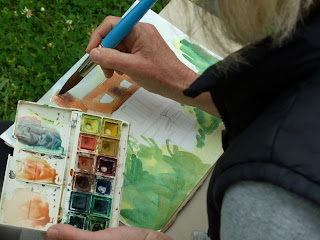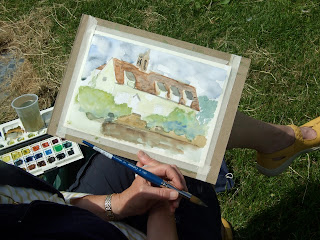Despite this looking like a dull day today, it was a balmy 23 . C, and hardly a breath of wind, & no direct sunlight, which made for easy painting conditions, and so I had planned to take my wed watercolourists back to Comberton village green to finish last weeks painting of the house on the green, however 1 or 2 had done as much as they wanted to on that, and as I am recovering from being unwell, did not want to teach on the green as this particular spot is very noisy, and it would have taken more energy than I had to make myself heard, so we took a vote on it, and decided to paint the big house by Comberton church, in a lovely secluded field which was very peaceful.

I had decided whichever situation we chose to paint, it would be a good idea to address some drawing issues from last week, as most learners had gone ahead and drawn the doors and windows before they had checked that the proportions of the basic structure was accurate.
So I had them do the same measuring procedure as my drawing class this week, ( see previous blog for details )
this was my drawing class exercise ( below )
and last weeks house on the green exercise ( above ) And this weeks house was sketched out by me ( below ) as a quick demo in the same way as the other other two to get the right proportions and angles
And this weeks house was sketched out by me ( below ) as a quick demo in the same way as the other other two to get the right proportions and angles
Learners work, above and below
at the end of the class we had a group discussion, to see how we got on with it, and in response to my learners questions about how to proceed with a second or third wash, I showed them some paintings by Juliet Palmer ( below ) to illustrate that the amount of additions to washes once the main values have been blocked in, will be guided by the artist own choice about how detailed they want the final painting to be, and if detail is to be added, it must be born in mind, that overall picture balance of colours and tone is something which must be constantly assessed, my suggestion for doing this was to hold the painting upside down, or to look at it in the mirror, or squint, or sleep on it, ( not literally ), and judge for yourself, where your eye is being pulled, is that the focal point you really want? is it too intense? too dark? too detailed? Re- balance your picture to frame your focal point, or to keep the viewers eye moving where you want it to go.
This beautiful painting by Juliet Palmer ( below ) is absolutely filled with detail, which she has managed to organize so you have 2 subtle focal points of white, center, and center left bottom.
However, try to look beneath the detail, and you will notice basic value washes that would have looked very similar to Ron Ranson's very loose painting of a country lane, ( bottom of the page ) my own first wash on the Comberton mansion, and my learners work today.
I think both of these paintings are delightful as finished paintings, so it's up to you which approach you want to take, but next week we'll be going for the juliet palmer approach, as I want you to choose your style based on an ability to do both competently, and as a progression from basic washes.
Painting by Ron Ranson V
The sun came out for my thursday class. : )















































